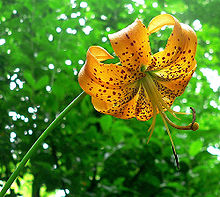Lilium iridollae
| Lilium iridollae | |
|---|---|

| |
| Scientific classification | |
| Kingdom: | Plantae |
| Clade: | Tracheophytes |
| Clade: | Angiosperms |
| Clade: | Monocots |
| Order: | Liliales |
| Family: | Liliaceae |
| Subfamily: | Lilioideae |
| Tribe: | Lilieae |
| Genus: | Lilium |
| Species: | L. iridollae
|
| Binomial name | |
| Lilium iridollae M.G.Henry
| |
Lilium iridollae is a species of Lilium or lily. It is a perennial forb. This species is considered one of five known Lilium species native to specific sites in the United States' southeast region.[1] In 1940, this species was discovered by Mary Henry in its habitat. She named the lily in reference to a "pot of gold at the end of the rainbow".[1]
Lilium iridollae is the most demanding of specific conditions, that is one reason why this lily has been elusive to many enthusiasts.[1] In general, the southeastern region of the United States is not considered "lily growing country" since it has warm winter temperatures and high humidity which are not suitable conditions for garden lilies.[1]
Common names
Lilium iridollae is more commonly known by these two names: pot-of-gold lily and panhandle lily. In Florida and Alabama, Lilium iridollae is referred by panhandle lily. In North Carolina, South Carolina, and Virginia, Lilium iridollae is referred to as pot-of-gold lily.[2]
Distribution

Lilium iridollae grows along
The balance of the
Description
The
Pollination

Lilium iridollae and many other related species are
Growth and reproduction
Lilium iridollae are
Seed is light brown and delayed-hypogeal without stratification in 1–2 months.
There are often situations where Native lilies neglect to flower if the conditions are not right. In that case, they might spend years appearing each spring as a basal rosette of leaves.[4] In addition, young plants, in optimal conditions, take more than two years to develop into a flower from a seed because they mature at a slow pace.[4]

Lilium iridollae is closely related to

Lilium michauxii or Carolina Lily is another species similar to Lilium iridollae. Lilium michauxii has flowers that resemble flowers of Turk’s Cap Lily, but the differences are that the flowers are fragrant and the stem is only 2 – 3 feet tall. In addition, the leaves are broadly lance-shaped.[5]
Protection and management
Since Lilium iridollae has become an endangered and threatened species there are ways to protect and manage them. One way is to protect streams from
Gallery
-
Lilium iridollae
-
Lilium iridollae


